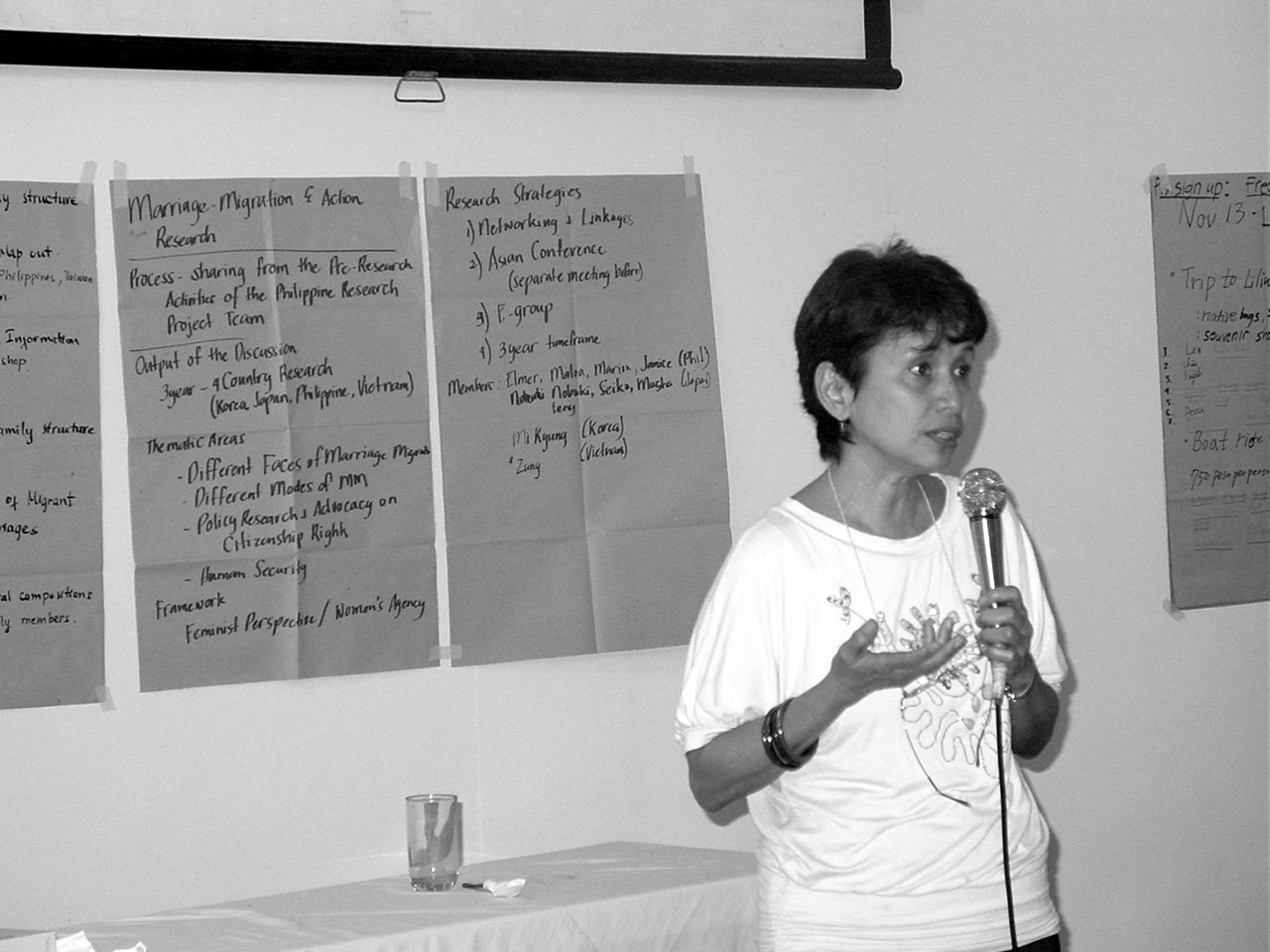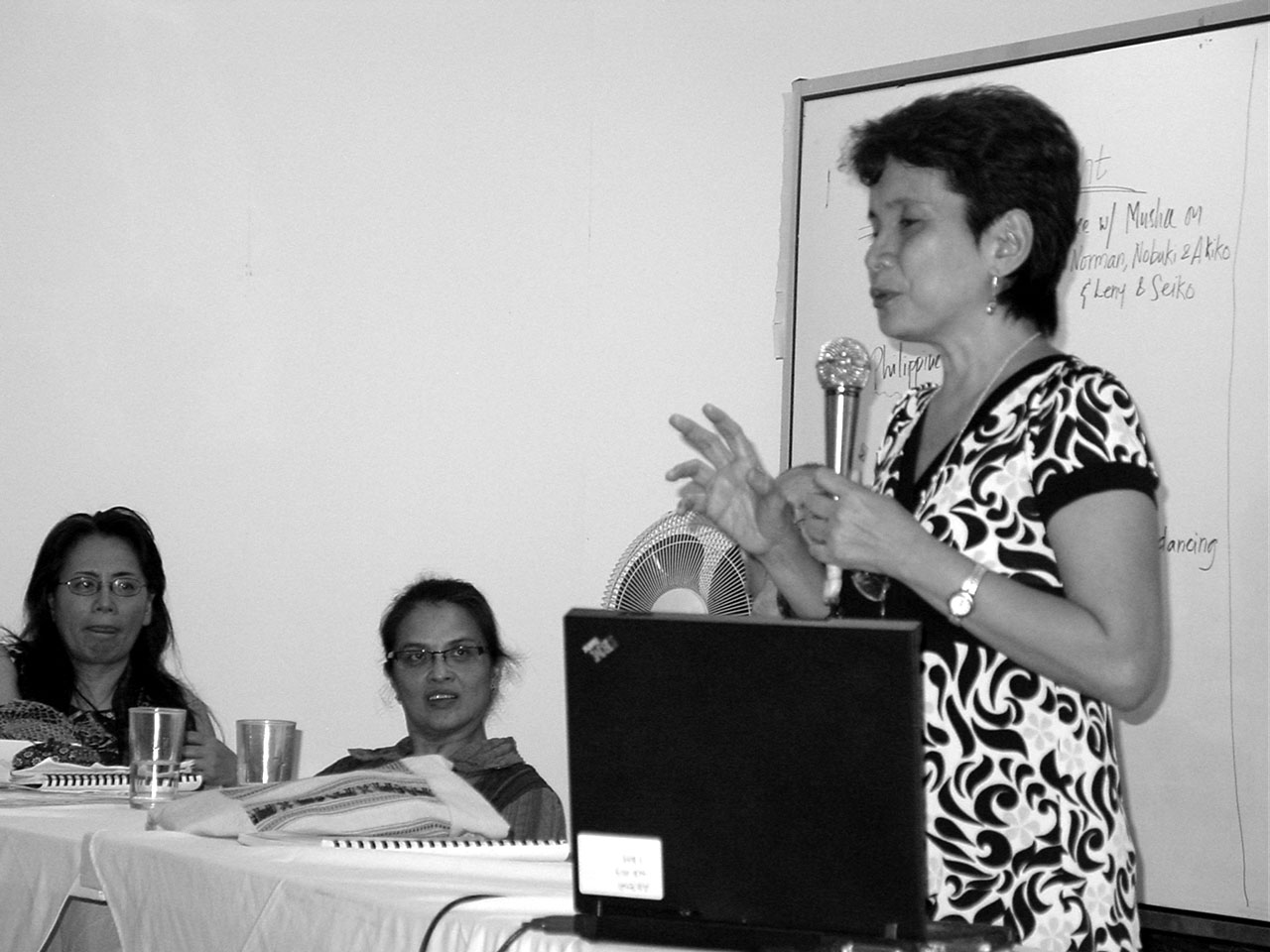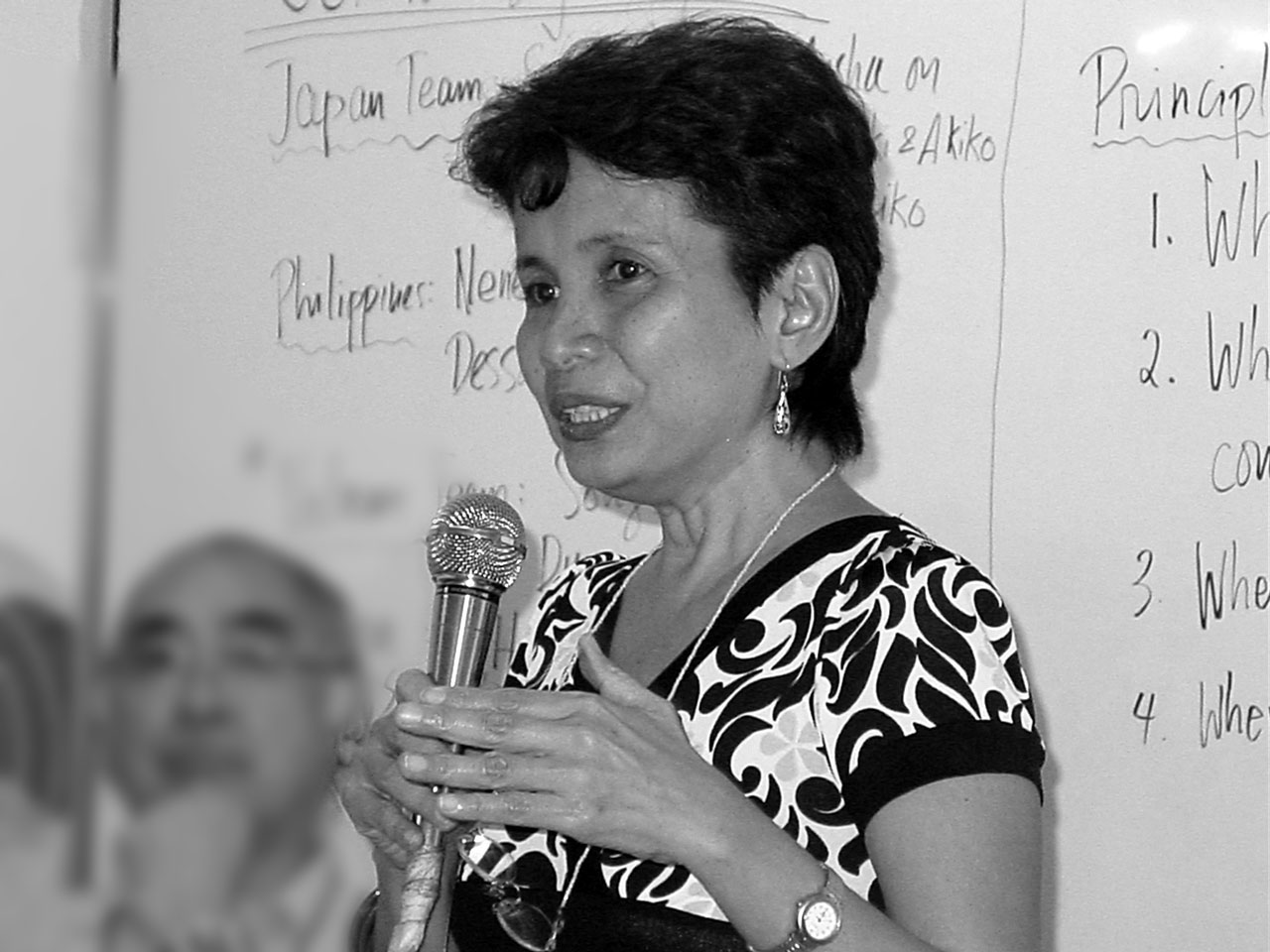Diaspora: Moving Beyond Minority Status
The Philippine Research Project Team (PRPT) on marriage migration has just completed its pre-research phase. It discussed the concept of “diaspora” in its search of a theoretical framework and conducted a review of related literature. This paper contains ideas on “diaspora” which we found to have potential as analytical constructs, most of them coming from Dr. Avtar Brah’s article entitled “Diaspora, Borders, and Transnational Identities.”
 Diaspora: A Range of Definitions
Diaspora: A Range of Definitions
Filipino activists and advocates like me in the field of international labour migration have long used “diaspora” to refer to the “scattering” or “dispersal” the world over of more than 8 million Filipino workers. Beyond this, we have not done any closer investigation. Not until now, that is.
The Classical Diaspora Paradigm
Milton Esman (1996: 316) provides the “classic” definition. A diaspora is “a minority ethnic group of migrant origin which maintains sentimental or material links with its by Maureen C. Pagaduan land of origin, either because of social exclusion, internal cohesion or other geo-political factors. It is never assimilated into the whole society but in time, develops a diasporic consciousness which carries out a collective sharing of space with others.”
Safran (1991) identifies the key components of the classical diaspora paradigm: dispersal from a homeland, collective memory of the homeland, lack of integration in the receiving country, a “myth” of return, and a persistent link with the homeland.
What this paradigm underscores are two fundamental tenets: the link between a group and a particular territory (a homeland), and an essentialist identity paradigm of the nation-state (Toninato).
Postmodern Versions (Hall 1990, Gilroy 1993, Clifford 1994, Brah 1996)
Under postmodernism, diaspora ceases to be merely descriptive of a group. Postmodernist discourse now refers to a “condition” which arises from the “experience of being from one place and of another,” and is linked “with the idea of particular sentiments towards the homeland, whilst being formed by those of the place of settlement. This place is one where one is constructed in and through difference, and yet is one that produces differential forms of cultural accommodation or syncretism: in some versions, hybridity” (Clifford: 1994).
Emphasis is on the particularities of the process of territorial and culture shifts such as issues on the destabilising effects of transition and movement of the individual’s cultural certainties, and the changes that take place in all social parts, not only in the diasporic group.
This interpretation of “diaspora” refers to a process at the holistic level (political, cultural, and economic dimensions at the micro-meso-macro levels), and is not limited to group or intergroup relations/dynamics. The process takes place in the context of globalisation and cultural mixing (hybridity/syncretism).
Clifford’s main ideas are as follows:
- Diasporas think globally but live locally. They are “bonds of ethnic ties, and the fixity of boundaries have been replaced by shifting and fluid identity boundaries…that alter the ethnic landscape.”
- Selective accommodation: the desire to stay and be different. Identity becomes more syncretic- e.g., British-born Cypriots, Australian Greeks, British Blacks. This challenges the notion of a nation-state as the embodiment of a given national group, constructing it as “trans-ethnic and transnational.” (Implication: The myth of the purity of the bloodline of a receiving nation-state is challenged and deconstructed, eventually replaced by a new concept of a transnational, trans- ethnic one.)
- While their specific identities imply a certain degree of boundedness and stability, diasporas must be understood as social and cultural processes of movement and change. Imagined as communities, diasporas are transnational in nature rather than mere ethnic or immigrant minority groups situated in a specific nation-state since they represent “ways of conceiving community, citizenship, and identity as simultaneously here and elsewhere.”
- Diasporas are viewed as “cultural and social products of transnational capitalism’’ that “follow and express distinct maps/histories—linking ‘first and third’ worlds, urban and rural zones, national or transnational margins and centres.”
 Anderson (1991), on the other hand, sees diaspora as an imagined political community ... “because the members of even the smallest nation will never know most of their fellow-members, meet them, or even hear of them, yet in the minds of each lives the image of their communion.”
Anderson (1991), on the other hand, sees diaspora as an imagined political community ... “because the members of even the smallest nation will never know most of their fellow-members, meet them, or even hear of them, yet in the minds of each lives the image of their communion.”
Jonathan Y. Okamura of the University of Hawaii (Manoa) in his paper, “The Global Filipino Diaspora as an Imagined Community,” asserts that global Filipinos are not an ethnic minority but a diaspora community. The Filipinos’ links with their homeland are especially seen in their remittances, the regular sending of goods via the “balikbayan boxes,” and the philanthropy (now commonly referred to in the Philippines as “diaspora philanthropy”) extended to their hometowns that has helped in infrastructure development and delivery of social ser vices, among others. According to Okamura, such transnational circulations of capital, labour, goods, and information “distinguish diaspora communities from other racial and ethnic minorities that may no longer maintain such emotionally close and economically significant relations with their home countries.”
Brah (2003) offers a set of powerful ideas on diaspora, including the view that diaspora is a historical narrative about journeys that involve settling down in another place outside the homeland. The narrative is also about the different forms of relationality internal to and among diasporic formations. As an example, Brah cites the history of South Asians in Britain which is different from, albeit related to, the history of the South Asians in the United States or in Africa.
The identity of the diaspora as an imagined community is neither fixed nor pre-given. Brah describes diasporic journeys as “embarked upon, lived and re-lived through multiple modalities…for example, of gender, ‘race,’ class, religion, language and generation.” Thus, they are “differentiated, heterogeneous, contested spaces, even as they are implicated in the construction of a common ‘we’.”
On the desire to return to the homeland, Brah asserts that not all diasporas sustain an ideology of “return.” Members of a diasporic community may stake out their claim in the receiving country and assert their identity as citizens. For instance, a Filipina married to a Japanese and residing in Japan may continue to regard the Philippines as home because of social exclusion, the denial of what Brah calls “everyday lived experience.” Another Filipina in the same situation may assert herself to be Japanese precisely to oppose the narrative that
she cannot be one.
Brah uses as a conceptual grid the three concepts of diaspora, border, and politics of location in a historicised analysis of current trans/national movements of people, information, cultures, commodities and capital. Since diasporas involve journeys, they cross borders. Borders do not only refer to territorial and political boundaries. According to Brah, they are also metaphors for psychological, sexual, spiritual, cultural, class and racialised boundaries that are arbitrarily constructed, leading to the exclusion and marginalisation of diaspora
communities.
The politics of location as locationality in contradiction came out of the feminist debate on issues of home and location, displacement, and dislocation. It analyses the position of the migrant as a subject who is influenced by various structures and processes in her environment.
Brah introduces the concept of “diaspora space” as the intersection of diaspora, border, and dis/location which is “a point of confluence of economic, political, cultural and psychic processes.” “This diaspora space is occupied not only by the migrants and their descendants but also by those who are “constructed and represented as indigenous.” Brah cites as an example the diaspora space called “England” where diasporas such as the African-Caribbean, the Irish, Asian, Jewish and many others “intersect among themselves as well as with the entity constructed as ‘Englishness,’ thoroughly reinscribing it in the process.”
Recognition is also given to the existence of power relations in discourses, institutions, and practices. For example, when an immigrant wife of a Korean is advised by an NGO to go out of her way to serve and please her husband as a way of ensuring the success of the marriage, does it promote gender equality? Or does it reinforce the power inequality in favour of the husband?
Finally, instead of discussing diasporas in terms of majority-minority relations, Brah puts forth a “multi-axial understanding of power” to emphasise that one group of migrants constituted as a “minority” along one dimension of differentiation may actually be constructed as “majority” using another dimension. Class, gender, race, sexual orientation, generation, and religion are among the different axes of differentiation. The multi-axial understanding of power concerns itself with the following:
(i) Analysis of what makes a diasporic formation similar to or different from another
- Who travels?
- When? Under what circumstances?
- What socio-economic, political, and cultural conditions mark the trajectories of these journeys?
- What regimes of power inscribe the formation of a specific diaspora?
(ii) Analysis of the relational positioning of a diasporic group in a given context
- What are the circumstances of arrival and settling down in the country of destination?
- How and in what ways do these journeys conclude and intersect in specific places, specific spaces, and specific historical conjunctures?
- How and in what ways is a group included/excluded within the social relations of class, gender, racism, sexuality, or other axes of differentiation in the country to which it migrates?
- What is the nature and type of processes in and through which the collective “we” is constituted?
- Who is empowered and who is disempowered in the construction of the “we”?
- How are social divisions negotiated in the construction of the “we”?
- What is the relationship of the “we” to its “others” ? Who are these “others”? For Brah, this is the start of deconstructing “regimes of power” which differentiates one group from others in order to include or exclude it from the constructions of the “‘nation’ and the body politic, and which inscribe them as juridical, political, and psychic subjects..”
Concluding Comments
I find Brah’s concepts on diaspora, particularly the multi-axial understanding of power, extremely relevant to the analysis of the phenomenon of marriage migration, weaving as it does the political, economic, social, and cultural dimensions and processes at the subject, community, and macro levels. They provide multiple analytic tools with which to view marriage migrants in the totality of their situation. Moreover, they are radical and powerful, particularly for the marginalised as is often the case of marriage migrants. They expose and challenge regimes of power that inscribe the situation of migrants, and open the possibilities for the creation of trans-ethnic and transnational societies founded on respect for human rights, and ensuring peoples’ security, devoid of the majority/minority distinction.
In using diaspora as an analytic lens in the context of marriage migration, it may also be worth considering the following: the orientation and nature of activities in diaspora communities of the wives, (e.g., mutual support, welfare, and political organising to get recognition from the state), and the communities’ links with other immigrant formations and broad social movements.
References
Anderson, B. (1991). Imagined communities: Reflections on the origin and spread of nationalism. New York: Verso.
Brah, A. (2003). “Diaspora, Border and Transnational Identities” in Lewis, R. and Mills, S. (eds.), Feminist Postcolonial Theory: A Reader. Edinburgh: Edinburgh University Press.
Clifford, J. (1994). Sites of crossing: Borders and diasporas in late 20th Century expressive culture. The Seeger Lecture.
Society for Ethnomusicology, Seattle, WA. October 24. Filipinas 1994. Signed, Sealed, Delivered. December, pp. 16-18.
Esman, M. (1996). “Diasporas and international relations” in Hutchins, J. and Smith, A. (eds.), Ethnicity. New York: Oxford University Press.
Okamura, J. Y. The global diaspora as an imagined community. University of Hawaii at Manoa. <http://www.usc.edu/dept/LAS/CMTS/MonoPaper3-6.html>.
Safran, W. (1991). “Diaspora in modern societies: Myths of homeland and return.” Diaspora, 1 (1), 83-99.
Toninato, P. The making of gypsy diasporas. University of Warwick, United Kingdom. <http://www.diasporas.ac.uk/assets/The%20Making%20of%20Gypsy%20Diasporas.pdf>.





 The
The 
 Isis Resource Center holds one of the largest feminist collections of materials in the Global South. With 40 years of publication experience, Isis holds a vast collection.
Isis Resource Center holds one of the largest feminist collections of materials in the Global South. With 40 years of publication experience, Isis holds a vast collection.